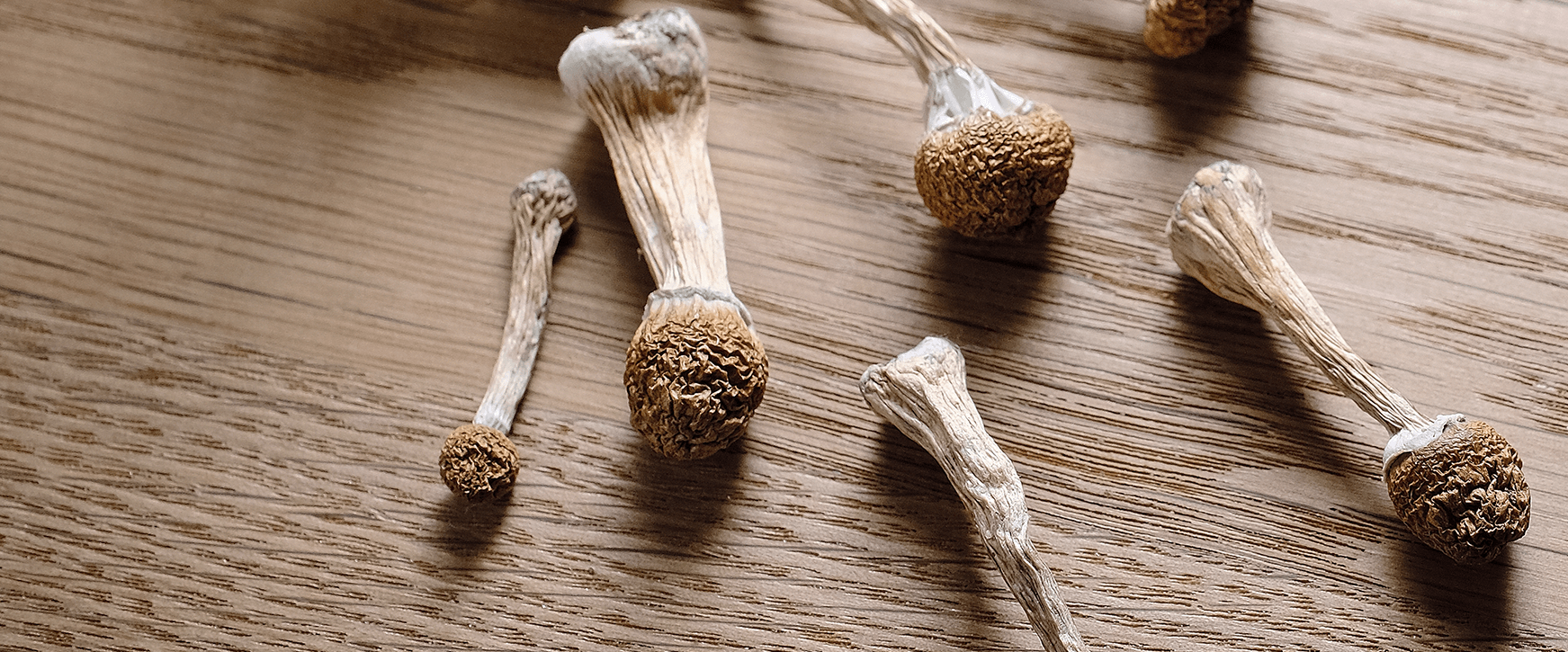
What is Psychedelic-Assisted Therapy?
Psychedelic-assisted therapy is the practice of using some form of psychedelic medicine to help deepen the connection to one’s self, while also furthering the process of psychotherapy by quieting the ego part of the brain, and expanding access to one’s unconscious. The most commonly used and researched psychedelic medicines being utilized these days are ketamine, psilocybin, LSD, and MDMA.
What are the various types of psychedelic-assisted therapies and how do they work?
Research is still ongoing, but what we are finding so far is that classical psychedelics like psilocybin and LSD help to temporarily shut down the ego part of our brains, and thus allow our brain and body to communicate more effectively with different parts of itself. So what does that mean exactly? In normal waking consciousness, our brains process around 300 billion bits of information per second; but we are only aware of a fraction of that—less than .000001%. There is a good reason for this, because if we were aware of all 300 billion bits of information coming in each second, we would be completely overwhelmed and would not be able to function at all. It is a good thing our brain’s natural state is to filter out most of this unnecessary information, allowing us to focus on and utilize what is most important to us in our lives at that moment—and thus keep us safe and alive.
The problem is that when it comes to certain mental health disorders such as depression, anxiety, trauma and addiction, our brain gets stuck on certain programs/loops, and we continually see the world through a distorted lens, and thus act accordingly, without much free will or clear understanding. We get stuck thinking and believing these impermanent states will become our permanent states (never going away), which leads to even more anxiety, stress, avoidance and depression, on and on in a vicious cycle. Our tendency as human beings is to completely avoid feeling or dealing with them, either by engaging in denial, resistance, repression, or through temporary escapism in the form of drugs, alcohol, work addiction, fitness addiction, unhealthy sex and porn use, unhealthy eating, etc. Similar to all living creatures on this planet, we tend to avoid and move away from that which is painful, and move towards that which is pleasurable. The problem, however, is that we never address the underlying pain/trauma and, therefore, never find real healing, peace of mind and joy in life.
Psilocybin-Assisted Therapy and LSD-Assisted Therapy
Psilocybin and LSD are considered “classic psychedelics”, in terms of how they affect one’s body and mind. The term “psychedelic” itself means “mind-manifesting” and there are no better molecules which fit that definition than psilocybin and LSD.
As mentioned above, when it comes to struggling with certain disorders like depression, anxiety, trauma and addiction, we tend to get stuck in certain patterns of perceiving, thinking, feeling and behaving—tending to see the world with blinders on and continually doing the same things over and over again with little or no change. The immense power of psilocybin and LSD comes from its ability to remove these blinders and the “mental programs” we all form after decades of living unexamined lives, thereby helping us re-visit and re-engage with unconscious memories and material from our past. They help us re-connect with disowned parts of ourselves, giving us the opportunity and the ability to integrate all of these separate parts into a healthy whole person—the definition of true healing.
Research has shown that an individual can experience Post-Traumatic Stress Disorder (PTSD) following a profoundly scary, life-threatening event — which occurs only one time, but continues to negatively impact that individual and his/her functioning for months or years into the future. We are finding the opposite happens with psilocybin and LSD-assisted therapy where, oftentimes, after only 1-2 psychedelic-assisted therapy sessions (followed by three 90 minute integration sessions), people have such a profoundly positive, life-changing experience, or spiritual awakening, that sticks with them and continues to positively impact them and their functioning for months and years to come.
These powerful medicines help remove the blinders we have unconsciously created for ourselves, and help remind us of our deep connection to ourselves and everyone and everything around us—whether you prefer to call it God, universal consciousness, source energy, etc. With this deep remembering and recollection of who we really are (i.e. spiritual beings having a human experience) and how intimately interconnected we are with everything and everyone around us — we find that, with this experience and new perspective, things like depression, anxiety, trauma and addictions tend to radically improve, if not disappear completely. And the amazing thing is that people do not have to keep using these medicines repeatedly to sustain these positive benefits and perspective shifts over time. Often, profound and sustained healing comes from just 1-2 experiences with these medicines when used properly with the right dose, the right therapist/facilitator, the right set, setting and intention, and with proper integration provided by a trained therapist. This last part—integration with a properly trained therapist—is often the MOST important part of the healing process. This is because anyone can have a powerful psychedelic trip or experience on their own. However, being able to take that experience and not only learn from it, but actively incorporate the lessons into one’s life, is what creates long-lasting change and healing.
One great example of this is the story and experience of Bill Wilson, the founder of Alcoholics Anonymous. Bill W had been trying unsuccessfully for years to cure his alcoholism — with nothing proving helpful. It wasn’t until Bill W experienced a powerful spiritual transformation from an LSD experience that he was finally able to stop drinking completely for the rest of his life. Most people don’t know that the impetus for Bill W’s spiritual transformation, which then became the basis of Alcoholics Anonymous and his 12-step program, was all due to his experience with LSD. In fact, Bill W was such a proponent of LSD and its powerful potential, that he wanted it to be given out at all future Alcoholics Anonymous meetings to other individuals struggling with alcoholism and addiction.
Interestingly enough, research on psilocybin being conducted at Johns Hopkins University for the last 20 years under the auspices of Dr. Roland Griffiths has found equally powerful results to Bill W’s experience with LSD. Research at Johns Hopkins University and other institutions around the country and around the world is consistently finding that macrodoses of psilocybin-assisted therapy helps immensely for terminally ill cancer patients struggling with end-of-life/death anxiety, as well as for individuals struggling with severe depression and addiction. They consistently find that roughly 70% of participants in these studies rate their experience with psilocybin-assisted therapy as one of the top five most influential experiences in their lives—on par with things like the birth of their first child, their wedding day, etc. In fact, the research has been so incredibly successful—far surpassing any other currently available treatments—that the FDA has granted “breakthrough” status to psilocybin, in order to help move it through the drug approval process more quickly.
MDMA-Assisted Psychotherapy: A Brief History of MDMA
MDMA, also known by its street name Ecstasy, has been around for decades. Most people don’t know that before it was made illegal in 1986 as a Schedule 1 substance with supposedly no medical benefits, it had been used by therapists in the late ‘70s and early ‘80s as a therapeutic tool to help with couple’s therapy.
MDMA is a very special molecule. There is no other medicine quite like it. MDMA acts as both an immediate acting stimulant, as well as an immediate acting anti-anxiety. It also stimulates neurohormones such as oxytocin and prolactin, which are the empathic bonding chemicals in our brains. These are the same bonding hormones which are released by both mothers and infants when breastfeeding, and during skin-to-skin cuddling. Another interesting thing about MDMA is that before it was made illegal, the DEA’s own board, as well as a federal judge ruling on the case, recommended it be classified as a schedule 3 substance, so that further testing and research could be performed on it. For some reason the DEA went against its own board’s recommendation, and classified MDMA as a schedule 1 illegal drug with no recognized medical use, thereby ending all scientific research into its possible benefits.
As you can imagine, there are a number of theories as to why the DEA went against its own board’s recommendation with this decision. Some people believe that because MDMA is such a special and unique molecule (which had already been patented by Merck back in 1913) that its potential threatened the pharmaceutical industry too much and the DEA caved in to pressure from the pharmaceutical lobby to classify it as a schedule 1 illegal drug. Whatever the reason, because of the DEA’s unfortunate decision not to follow the recommendation of the federal judge and its own board, MDMA was stolen from the scientific world for the past 37 years. Interestingly enough, in that same year (1986) Ketamine was classified a schedule 3 substance, and research was permitted to continue over all these years, which is why Ketamine has since been approved by the FDA to treat treatment-resistant depression.
If it were not for Rick Doblin and the non-profit organization he founded immediately after all of this happened back in 1986, MDMA and its incredible healing potentials would have been completely lost to the world. The ONLY reason MDMA is where it is today is because of Doblin’s ceaseless efforts through his organization MAPS (The Multi-disciplinary Association of Psychedelic Studies), and their ability to secure over $100 million in private funding these last 30+ years, to ensure America and the rest of the world did not throw away one of the most powerful, healing, game-changing medicines we have seen in a very long time.
The Current State of MDMA-Assisted Therapy
Currently MDMA-Assisted Therapy for PTSD is completing Phase 3 trials and should hopefully be approved by the FDA late in 2023 or early 2024. The reason MDMA was able to “catch up” so quickly to other medications like Ketamine, which have been researched for decades longer, is due to the incredible results being discovered for treating severe, treatment-resistant PTSD. Consistent research findings show that almost 70% of individuals who were diagnosed with severe, persistent PTSD, who had suffered for 10, 15, 20+ years with no therapies or medications proving helpful, were not only improving significantly, but many ended up completely free of their PTSD after only 2-3 MDMA-assisted psychotherapy sessions! The most amazing thing is that many of these individuals, who were completely cured after only 2-3 sessions, also displayed no ongoing symptoms of suicidality or PTSD for months and years into the future! Imagine, a safe medicine with little to no side effects, which you only need to take a couple of times with a trained therapist in order to obtain long-lasting relief. Because of these consistent, mind-blowing results, the FDA assigned “breakthrough status” to MDMA-assisted psychotherapy for treating PTSD a few years ago, and it is now in the final stages of the approval process.
Why is MDMA-Assisted Therapy so Effective?
As mentioned above, MDMA is a very special molecule. There is no other medicine quite like it which acts as both an immediate acting stimulant, as well as an immediate acting anti-anxiety. It also stimulates the neurohormones oxytocin and prolactin, which are the empathy-producing, bonding chemicals in our brains. MDMA primarily impacts the serotonin system in our body, which is responsible for mood. When you combine all of these effects, you get a very special medicine which helps calm the amygdala, or the emotional part of our brain responsible for our fight/flight/freeze reactions. MDMA floods the brain and body with “feel good” neurotransmitters and neurohormones which significantly improve one’s mood, as well as significantly enhance feelings of trust, safety, prosocial connection and strong feelings of empathy and love for self and others. All of this happens while also enhancing one’s ability for memory and recall of past events—without the emotional triggers and flashbacks which usually accompany trauma work.
This special combination allows people, sometimes for the first time ever, to talk about and start processing past traumas without becoming flooded, overwhelmed, and completely consumed by them. Our brains do not have a sense of time, especially when it comes to trauma. This is why people who suffer from severe, chronic PTSD and experience flashbacks, literally experience themselves being back in the traumatic situation as if it were happening again right now—whether it was 10 days, 10 months, or 10 years ago. Our brain cannot tell the difference between what is happening in waking, conscious reality, and what we see/experience in flashbacks, or in our dreams. To our brain and body it is the same thing. This is why dreams feel so real at times when we are having them. Similarly, people with severe PTSD, who are experiencing flashbacks feel they are back in the traumatic incident, re-experiencing it all over again, unable to differentiate past from present. MDMA-assisted therapy helps to calm that emotional trigger part of the brain (the amygdala), while enhancing memory and recall of the traumatic event–all wrapped in a calm, soothing blanket of love, empathy and trust. These effects, combined with the presence of a safe, informed, and trusted therapist to help guide the individual, make for a healing experience unlike any other.
How to Determine if Psychedelic-Assisted Therapy is Right for You, and How to Start Psychedelic-Assisted Therapy:
With all new clients, I first perform a 15-30 minute complimentary consultation call to gather preliminary information, as well as answer any questions you might have. If we seem to be a good fit to work with one another, I will accept you into my practice as a client, and then conduct a very thorough 60-90 minute intake assessment (what we call a biopsychsocial history) with you. This means gathering a wealth of information from your past history, as well as your current functioning. I also assess if there are any medical or mental health conditions which would prevent us from being able to do this work together.
After determining whether a client is a good fit for microdosing/macrodosing, or MDMA-assisted psychotherapy–and whether a client is currently in therapy/coaching, or has any professional support in their lives–we will meet for 2-3 preparation sessions to discuss the client’s intentions, desires, and needs. I will also educate the client about the medicine, what to expect, and how to get the most out of his/her experience. After the full day psychedelic-assisted therapy session with a co-facilitator of mine who is a female master’s level somatic healer and coach, we will start the integration process the next day and have 2-3 follow-up integration sessions, helping you make sense of your experience by exploring the imagery, bodily sensations and feelings/thoughts which arose for you during our full day psychedelic-assisted therapy session. We will then work to make meaning of this new experience and the information learned from it, and help you to integrate it into your life moving forward, so you are fully able to retain it.
Disclaimer: Please note that since these medicines are still technically illegal (Schedule 1 substances by the DEA), I am NOT able to provide them to you directly. However, similar to the way in which a psychiatrist works with a pharmacy to provide medications to their clients, I work with very safe and trusted producers/distributors, who will help provide you access to the correct medicine and dosage, once we determine whether it is appropriate fit for you.
Sources
- Fadiman, J. (2011) The Psychedelic Explorer’s Guide: Safe, Therapeutic, and Sacred Journeys. Park Street Press.
- Fischer, R., Hill, R., Thatcher, K., et al. Psilocybin-induced contraction of nearby visual space. Agents and Actions
- Everything You Wanted To Know About Microdosing (But Were Afraid To Ask). Huffingtonpost.com
- Harman, W. W.; McKim, R. H.; Mogar, R. E.; Fadiman, J.; Stolaroff, M. J. (1966). “Psychedelic agents in creative problem-solving: A pilot study”. Psychological Reports.
- McKenna, T (1992). Food of the Gods: The Search for the Original Tree of Knowledge. Bantam Books (N.Y. et al.).

“At a time when it was difficult to trust anyone, Dr. B provided a safe and supportive environment where I could be honest about my problem, and he gave me the tools to deal with them. I am proud to say that with the help of his expertise, good humor, and friendship, I am still sober today. “
I want to help you get control.
Let’s work together to overcome what’s in your way. While Los Angeles is my home, I can provide my concierge treatment anywhere in the world.
Get in Touch



